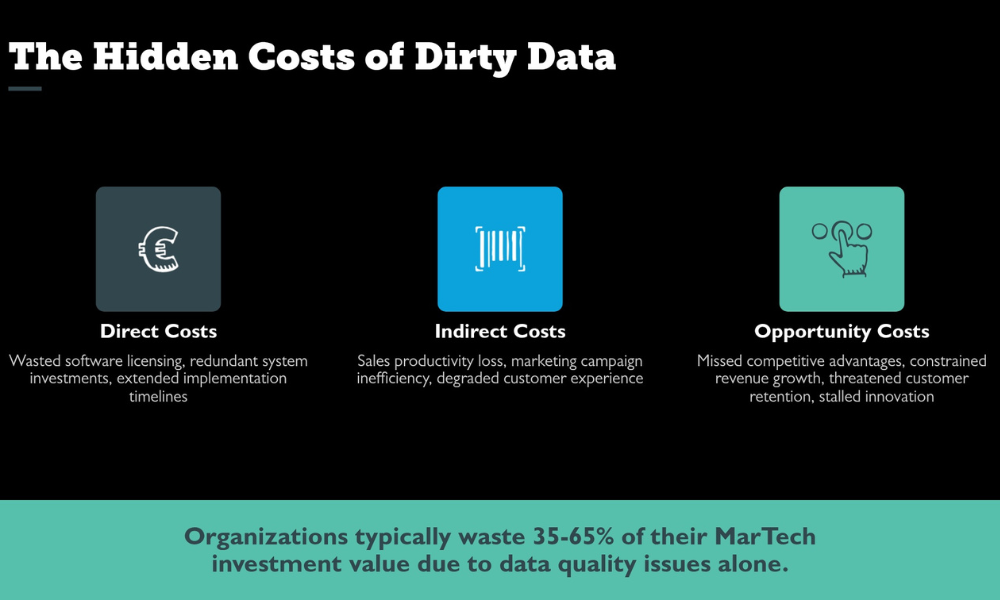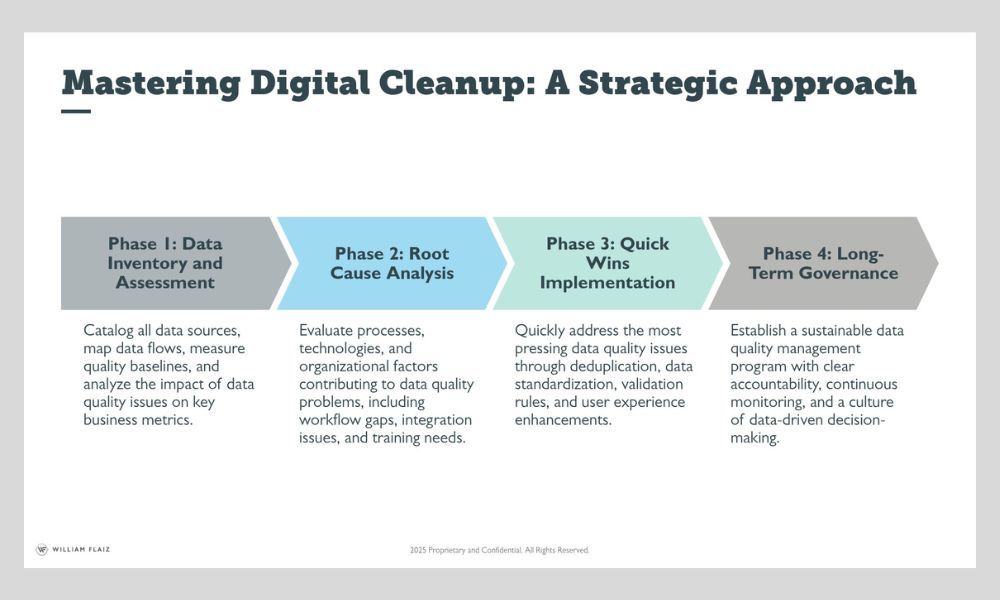The $500K Question: Why Your MarTech Stack Isn't Delivering ROI
I watched a healthcare client spend $480,000 on a Salesforce implementation, only to achieve a 12% user adoption rate six months later. The sales team called it "unusable." Marketing abandoned their automation workflows. Leadership questioned every technology decision.
The tools weren't broken. The data feeding them was.
This scenario plays out across industries with depressing regularity. Companies invest heavily in best-in-class MarTech platforms—Salesforce, HubSpot, Marketo, Pardot—then wonder why their ROI resembles a flat line instead of a hockey stick.
After helping organizations across pharmaceutical, financial services, education, and SaaS sectors recover millions in MarTech investments, I've identified the core issue: 84% of MarTech failures stem from data quality problems, not tool selection.

The $500K Symptom vs. The Root Cause
Most executives diagnose MarTech underperformance as a platform problem.
"Salesforce doesn't fit our sales process."
"HubSpot's automation is too complex."
"Marketo's reporting doesn't give us what we need."
These statements mask the real culprit: garbage data input creating garbage insights output.
Consider the ripple effects of poor data quality across your MarTech ecosystem:
Sales Impact
- Duplicate records create confusion and missed opportunities
- Incomplete contact information prevents timely follow-up
- Inconsistent lead scoring undermines prioritization
- Poor data hygiene destroys trust in the system
Marketing Impact
- Segmentation becomes impossible with inconsistent categorization
- Personalization fails when customer profiles are incomplete
- Attribution modeling breaks down with fragmented tracking
- Campaign optimization relies on flawed performance data
Revenue Impact
- Sales cycles extend when teams can't find accurate information
- Customer satisfaction drops due to irrelevant communications
- Decision-making slows when data reliability is questioned
- Competitive advantage erodes as agility decreases
The Cross-Industry Reality Check
This problem transcends sectors. In my consulting work, I've seen identical patterns across vastly different industries:
- Financial Services: A regional bank implemented Pardot for mortgage lead nurturing but saw 23% email bounce rates due to outdated contact data. Their sophisticated scoring models were calculating based on incomplete prospect information.
- Education Technology: An education platform migrated 150,000 contacts to a new marketing automation system without cleaning duplicate records first. Result: customers received multiple conflicting messages, damaging brand trust.
- Pharmaceutical: During a global website consolidation project, we discovered 1,200+ unmanaged digital properties feeding inconsistent data into CRM systems across 90 countries. The data fragmentation was creating compliance risks and operational inefficiencies.
Key Lesson: Industry sophistication doesn't protect against basic data hygiene failures. Organizations with complex regulatory requirements often have worse data quality due to system complexity and stakeholder proliferation.
The Hidden Costs of Dirty Data
Most leaders underestimate the true cost of poor data quality because the impact compounds across multiple business functions:
Direct Costs
- Wasted software licensing (unused or underutilized tools)
- Redundant system investments to solve perceived platform limitations
- Extended implementation timelines due to data migration challenges
- Additional consulting spend to "fix" tools that aren't broken
Indirect Costs
- Sales team productivity loss searching for accurate information
- Marketing campaign inefficiency due to poor targeting
- Customer experience degradation from irrelevant communications
- Decision-making delays while validating data accuracy
Opportunity Costs
- Competitive advantages missed due to slow market response
- Revenue growth constrained by poor lead management
- Customer retention threatened by communication missteps
- Innovation stalled by lack of reliable performance data
Based on my experience across multiple implementations, organizations typically waste 35-65% of their MarTech investment value due to data quality issues alone.

The MarTech Data Quality Audit Framework
Here's the systematic approach I use to diagnose and resolve data quality issues across any MarTech stack.
Phase 1: Data Inventory and Assessment (Week 1-2)
Data Source Mapping
- Catalog all systems feeding your MarTech stack
- Document data flow patterns and integration points
- Identify manual data entry processes and workflow gaps
- Map data ownership and governance responsibilities
Quality Baseline Measurement
- Calculate duplicate record percentages across key entities
- Measure data completeness for critical fields (aim for 90%+ on core attributes)
- Assess data consistency across integrated systems
- Evaluate data freshness and update frequency
Impact Analysis
- Quantify revenue attribution accuracy
- Measure campaign performance reliability
- Assess sales productivity metrics
- Calculate customer satisfaction correlation with data quality
Phase 2: Root Cause Analysis (Week 3)
Process Evaluation
- Review data entry training and standard operating procedures
- Analyze integration error handling and data validation rules
- Identify workflow bottlenecks creating data quality shortcuts
- Assess change management around data governance
Technology Assessment
- Evaluate data validation rules and constraints
- Review integration monitoring and error reporting
- Assess backup and recovery procedures for data integrity
- Analyze user interface design impact on data entry quality
Organizational Analysis
- Review data governance roles and responsibilities
- Assess performance incentives alignment with data quality
- Evaluate cross-functional communication about data standards
- Identify training gaps and knowledge transfer issues
Phase 3: Quick Wins Implementation (Week 4-6)
Immediate Data Cleanup
- Deduplicate records using fuzzy matching algorithms
- Standardize formatting for key fields (phone numbers, addresses, company names)
- Enrich incomplete records with third-party data sources
- Archive obsolete records to reduce system noise
Process Improvements
- Implement mandatory field validation for critical data points
- Create data entry templates and standardized workflows
- Establish regular data hygiene maintenance schedules
- Deploy real-time duplicate detection and prevention
User Experience Enhancements
- Simplify data entry interfaces to reduce errors
- Add autocomplete and suggestion features for consistency
- Create data quality dashboards for ongoing monitoring
- Implement user feedback loops for continuous improvement
Phase 4: Long-Term Governance (Ongoing)
Governance Structure
- Establish data stewardship roles with clear accountability
- Create cross-functional data quality review processes
- Implement regular data quality reporting and scorecards
- Develop escalation procedures for data quality issues
Technology Evolution
- Deploy AI-powered data quality monitoring tools
- Implement predictive data quality scoring
- Automate data enrichment and correction workflows
- Establish data lineage tracking for impact analysis
Cultural Transformation
- Align performance metrics with data quality outcomes
- Create data quality training programs for all user roles
- Celebrate data quality improvements and success stories
- Foster cross-functional collaboration around data standards

Measuring Success: The ROI Recovery Metrics
Track these key performance indicators to measure your data quality improvement impact.
Data Quality Metrics
- Duplicate record percentage (target: <2%)
- Data completeness for critical fields (target: >95%)
- Data accuracy verification scores (target: >98%)
- System adoption rates (target: >85%)
Business Impact Metrics
- Sales cycle velocity improvement
- Marketing campaign performance lift
- Customer satisfaction score increases
- Revenue attribution accuracy gains
Operational Efficiency Metrics
- Time spent on data entry and cleanup
- System integration error rates
- Report generation accuracy and speed
- User productivity and satisfaction scores
Implementation Success Stories
- Financial Services Transformation: After implementing this framework with a regional financial institution, we achieved a 3.5x ROI improvement on their CRM investment within eight months. The key breakthrough came from eliminating 47% duplicate records and implementing real-time data validation.
- Healthcare Technology Recovery: An education platform saw 28% revenue growth after cleaning their marketing automation data and implementing proper lead scoring based on accurate customer information. The data cleanup revealed market segments they didn't know existed.
- Global Pharmaceutical Success: During a website consolidation project spanning 90 countries, we projected 52% cost reduction through improved data governance and unified customer data management. The strategy was successfully implemented, validating the approach.
Key Lessons:
- Start with data quality before adding new MarTech tools
- Involve stakeholders from legal, compliance, and operations early
- Focus on business outcomes, not technical perfection
- Build governance processes that scale with organizational growth
Your Next Steps
Don't let dirty data continue sabotaging your MarTech investment.
Here's how to start:
- Week 1: Conduct a rapid data quality assessment using the framework above. Focus on your highest-value customer segments first.
- Week 2: Identify your top three data quality issues and their business impact. Calculate the cost of inaction versus cleanup investment.
- Week 3: Implement one quick win that demonstrates immediate value. Use this success to build momentum for larger initiatives.
- Week 4: Establish ongoing governance processes to prevent future data quality degradation.
Remember: every day you delay addressing data quality issues, your MarTech ROI continues deteriorating. The tools you've invested in are capable of delivering transformational results—when fed clean, reliable data.
Your $500K+ MarTech stack isn't broken. It's just hungry for better data.
How long does it typically take to see ROI improvements after implementing data quality fixes?
Most organizations see initial improvements within 30-60 days of implementing basic data cleanup and governance processes. Significant ROI recovery typically occurs within 6-12 months, depending on the scale of data quality issues and organizational complexity.
Should we fix our data quality issues before implementing new MarTech tools?
Absolutely. Implementing new MarTech platforms on top of dirty data multiplies your problems and wastes investment. Clean your existing data first, establish governance processes, then evaluate whether new tools are still necessary. Many organizations discover their current tools work perfectly with clean data.
What's the biggest mistake companies make when trying to improve MarTech ROI?
The biggest mistake is treating data quality as a one-time project rather than an ongoing discipline. Organizations often spend months cleaning data, see immediate improvements, then gradually return to poor data hygiene practices. Sustainable ROI requires permanent governance processes and cultural changes around data stewardship.
Author: William Flaiz










